More critters! Mostly birds. And one insect. Let me tell you 'bout the birds and the
Day 36: Black-crowned night heron, Nycticorax nycticorax
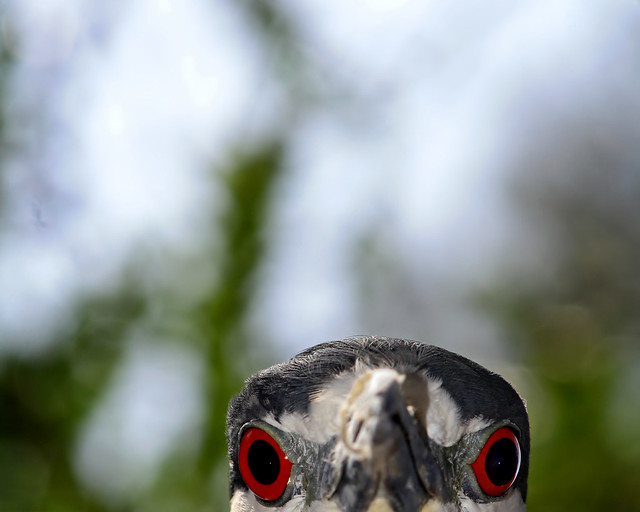
The scientific name for black-crowned night heron means "night raven," and it fits them well. Their call, like the namesake, is a bark. They rest during the day, hunched in an out-of-the-way cluster of branches, but you can catch them early in the morning or late in the evening, hunting at the water's edge. No, hunting's not quite right. They ambush. These guys employ the slow-mo stalk even more than the snowy egret I mentioned last week. They're all bold grays, blacks, and whites; their eyes are fire-engine red (juveniles are a warmer, streaked brown-gray with orange-red eyes), but they seem to think nothing will see them if they move really slowly. And it seems to work. If they feel their space is being invaded, say, by an eager photographer, they let out a harsh WAAAAK and fly away while the photographer is still recovering from her cardiac event.
 Black-crowned night herons are fairly common throughout their range. Look in the trees during midday or along the water's edge when shadows are long. Their necks extend surprisingly far when they see a fish, but for the most part they hunch, aiming for inconspicuousness, the better to freak you out when you startle one. Look for a grouchy football with yellow legs, beady red eyes, and a black crown.
Black-crowned night herons are fairly common throughout their range. Look in the trees during midday or along the water's edge when shadows are long. Their necks extend surprisingly far when they see a fish, but for the most part they hunch, aiming for inconspicuousness, the better to freak you out when you startle one. Look for a grouchy football with yellow legs, beady red eyes, and a black crown.
Day 37: American avocet, Recurvirostra americana
American avocets. I see them every time I visit the Gilbert Riparian Preserve, and I hardly ever capture good photos of them. That's because, as far as I can tell, they're always moving. I shouldn't feel too slighted, I suppose -- avocets are able to fool predators, not only with flight and speed but with their call. An avocet can make a series of calls that change pitch, simulating the Doppler effect and masking their true location as they approach or flee.
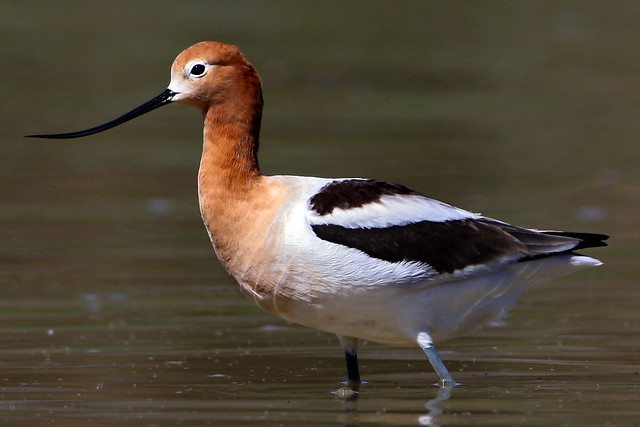 Avocets are in the same family as stilts, and they're often seen together. Their plumage is black and white on the back and wings and white on the belly, with rusty coloring on their head and chest in the spring and summer, when they're in breeding plumage. (The rusty feathers turn a cool gray in non-breeding winter plumage). Their legs, which trail behind them when they fly, are a gorgeous blue-gray. They are migratory, but we have some American avocets here in Arizona year-round.
Avocets are in the same family as stilts, and they're often seen together. Their plumage is black and white on the back and wings and white on the belly, with rusty coloring on their head and chest in the spring and summer, when they're in breeding plumage. (The rusty feathers turn a cool gray in non-breeding winter plumage). Their legs, which trail behind them when they fly, are a gorgeous blue-gray. They are migratory, but we have some American avocets here in Arizona year-round.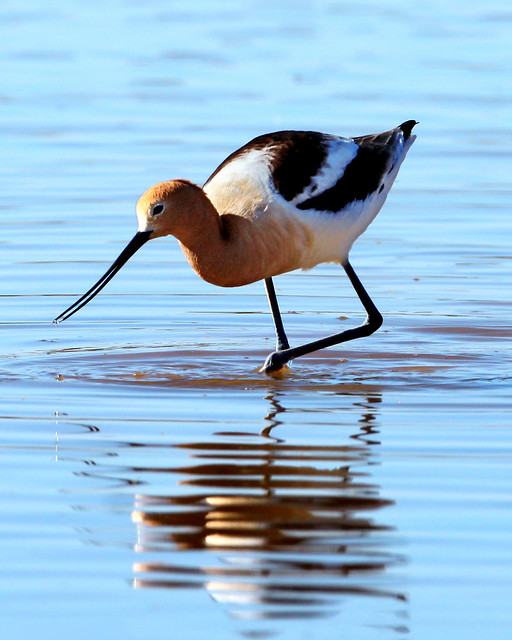 Avocets feed on small animals in the water by sweeping their thin, upturned bills (the female's is slightly more upturned) in a back-and-forth motion. I never noticed until doing this that each bird feeds in a slightly different fashion -- avocets by sweeping, black-necked stilts with plunging grabs, and long-billed dowitchers with that up-and-down, up-and-down sewing-machine motion. It's like watching my son and his friends' distinct eating habits, only with the birds, no one ends up blowing his nose on a napkin or wearing a pizza-sauce Glasgow smile.
Avocets feed on small animals in the water by sweeping their thin, upturned bills (the female's is slightly more upturned) in a back-and-forth motion. I never noticed until doing this that each bird feeds in a slightly different fashion -- avocets by sweeping, black-necked stilts with plunging grabs, and long-billed dowitchers with that up-and-down, up-and-down sewing-machine motion. It's like watching my son and his friends' distinct eating habits, only with the birds, no one ends up blowing his nose on a napkin or wearing a pizza-sauce Glasgow smile.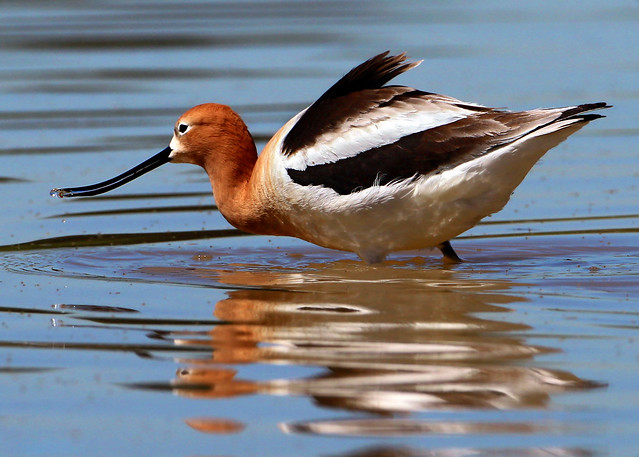
Day 38: Crane fly, Tipulidae
People freak out about these gangly insects, though they're completely harmless. Sometimes called mosquito hawks, sometimes called just "big-ass mosquitoes," and sometimes called "AGHHHGetitawayfromme," crane flies feed hardly at all, and when/if they do, it's on nectar, not blood or actual mosquitoes.
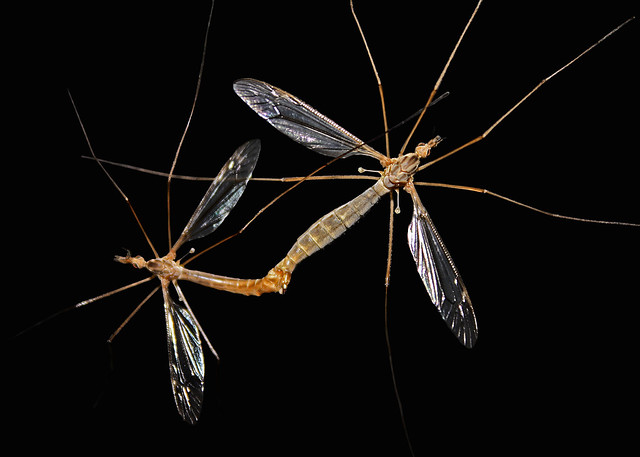 Over 4,200 species of crane flies have been described, mostly by American entomologist Charles Paul Alexander, which makes Tipulidae the largest family of Diptera (the order to which all flies belong), and makes Charles Paul Alexander someone who can make me feel either better or worse about my passion by comparison -- he described around 11,000 species and genera of flies, which works out to about one a day for his entire career. Suddenly this Species a Day thing doesn't seem nearly as ambitious.
Over 4,200 species of crane flies have been described, mostly by American entomologist Charles Paul Alexander, which makes Tipulidae the largest family of Diptera (the order to which all flies belong), and makes Charles Paul Alexander someone who can make me feel either better or worse about my passion by comparison -- he described around 11,000 species and genera of flies, which works out to about one a day for his entire career. Suddenly this Species a Day thing doesn't seem nearly as ambitious. Unfortunately, I don't have Chuck around to ask for the exact genus and species of this pair, which is just one of probably hundreds of pairs I've seen in the last few weeks. They're particularly fond of my back patio at night, particularly if a certain 9-year-old has left the patio light on even when he said it was off -- I went out this night and it was Club Crane Fly for the whole length of the house. My son, of course, responded in the most natural fashion: "Awww, cute! Look! They're all mating! They're making baby crane flies!"
Unfortunately, I don't have Chuck around to ask for the exact genus and species of this pair, which is just one of probably hundreds of pairs I've seen in the last few weeks. They're particularly fond of my back patio at night, particularly if a certain 9-year-old has left the patio light on even when he said it was off -- I went out this night and it was Club Crane Fly for the whole length of the house. My son, of course, responded in the most natural fashion: "Awww, cute! Look! They're all mating! They're making baby crane flies!"(If ever I'm too worried that he'll feel pressured to conform, his entomological predilections alone should make him stand out from the crowd.)
Day 39: Ruddy duck, Oxyura jamaicensis
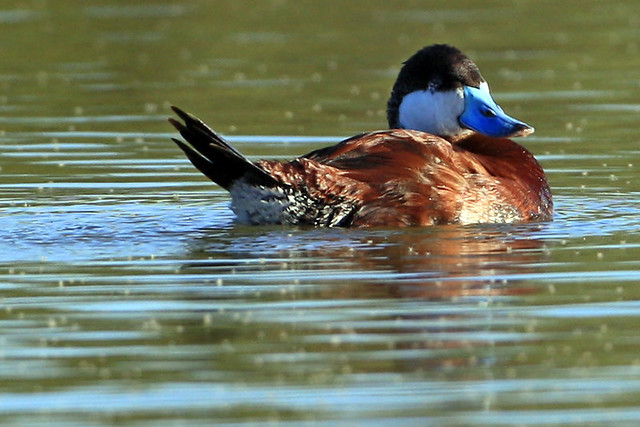 Ruddy ducks can be see year-round in some places in Arizona, but they tend to be shy, at least in my experience, and it's only when I spot a flash of powder blue in the distance that I take a second look. The breeding plumage of the males is quite striking, with rust-red bodies, broad blue bills, white faces, and black caps. Adult females have a gray-brown bodies and the bill is duller, but they are distinguished by lovely cheek stripes. Both species are more dull colored when they have their non-mating plumage, but I guess that's OK. I only dress up a few days out of the year, so at least they have me beat.
Ruddy ducks can be see year-round in some places in Arizona, but they tend to be shy, at least in my experience, and it's only when I spot a flash of powder blue in the distance that I take a second look. The breeding plumage of the males is quite striking, with rust-red bodies, broad blue bills, white faces, and black caps. Adult females have a gray-brown bodies and the bill is duller, but they are distinguished by lovely cheek stripes. Both species are more dull colored when they have their non-mating plumage, but I guess that's OK. I only dress up a few days out of the year, so at least they have me beat.Ruddy ducks are so named for their long, stiff tail feathers, which can act as a rudder when the birds dive.
Day 40: Osprey, Pandion haliaetus
 I've found some references where osprey are called "lesser eagles," though the more common, and more accurate, alternate reference is probably "fish hawk." These guys are expert fishers. Apparently rangers used to be instructed to shoot osprey on sight because they were so good at grabbing the fish from rivers and ponds.
I've found some references where osprey are called "lesser eagles," though the more common, and more accurate, alternate reference is probably "fish hawk." These guys are expert fishers. Apparently rangers used to be instructed to shoot osprey on sight because they were so good at grabbing the fish from rivers and ponds. Hopefully, we just watch them now. Seriously, it's pretty amazing. With huge round eyes, snow-white underparts, and striking long wings that bend at a sharp angle at the wrist joint, they're unmistakable if you know what to look for. If you do spot one, just watch. It will swoop above until it sees a fish, and then it plummets. Long, rounded talons (also round in cross-section) and spiky skin on the underside of the feet help them snatch fish from the water. Just about the only time ospreys don't look elegant is when they float, wings spread, on the water, before getting a secure grip on their meal and taking off again. They may nest locally wherever there are fish, and especially (in Arizona) along streams below the Mogollon Rim. You can tell the female from the male by a thin, broken "necklace" of brown across the white chest.
Hopefully, we just watch them now. Seriously, it's pretty amazing. With huge round eyes, snow-white underparts, and striking long wings that bend at a sharp angle at the wrist joint, they're unmistakable if you know what to look for. If you do spot one, just watch. It will swoop above until it sees a fish, and then it plummets. Long, rounded talons (also round in cross-section) and spiky skin on the underside of the feet help them snatch fish from the water. Just about the only time ospreys don't look elegant is when they float, wings spread, on the water, before getting a secure grip on their meal and taking off again. They may nest locally wherever there are fish, and especially (in Arizona) along streams below the Mogollon Rim. You can tell the female from the male by a thin, broken "necklace" of brown across the white chest.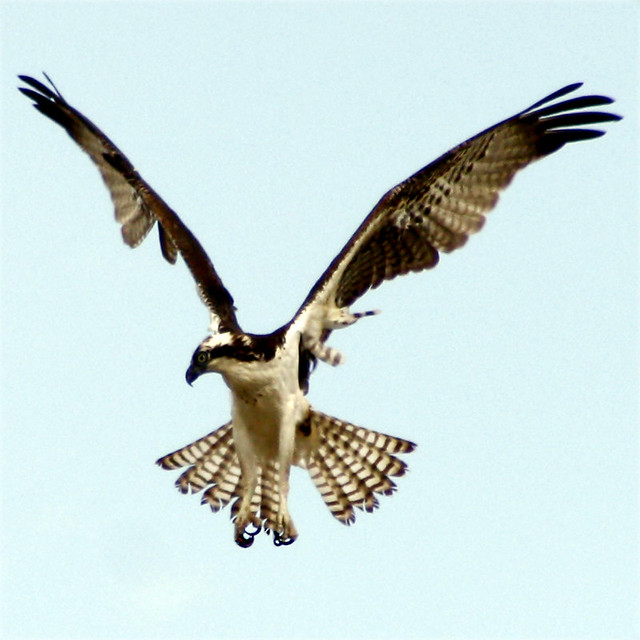
Day 41: Mallard, Anas platyrhynchos
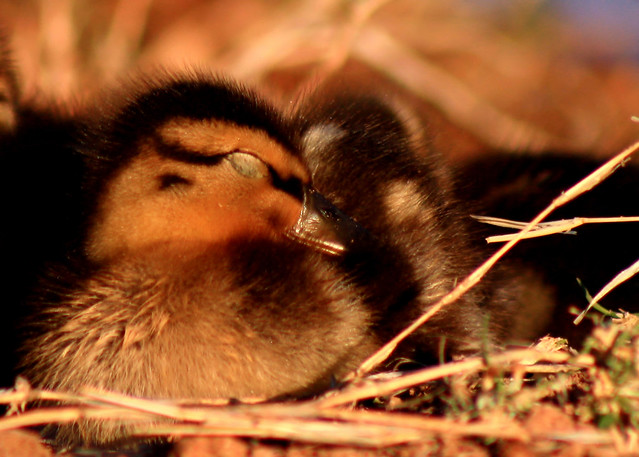 Mostly because this was too adorable to pass up. We all know what this one is. I know. Big deal. But what if someone told you there was a rare duck with striking white-and-brown plumage, deep blue wing patches, and an iridescent green head, that would come right up to you? Birders would lose their minds.
Mostly because this was too adorable to pass up. We all know what this one is. I know. Big deal. But what if someone told you there was a rare duck with striking white-and-brown plumage, deep blue wing patches, and an iridescent green head, that would come right up to you? Birders would lose their minds.It's not rare. Still, it is gorgeous.
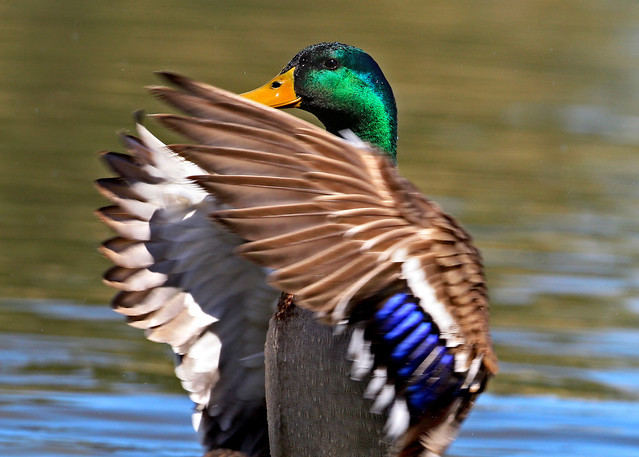 My son insists on visiting the ducks every time we go anywhere. He really doesn't care if there's a painted redstart or a something-or-other warbler in the trees. He doesn't care how common mallards are. He just wants to enjoy them. As with many children, mallards were his introduction to wildlife.
My son insists on visiting the ducks every time we go anywhere. He really doesn't care if there's a painted redstart or a something-or-other warbler in the trees. He doesn't care how common mallards are. He just wants to enjoy them. As with many children, mallards were his introduction to wildlife.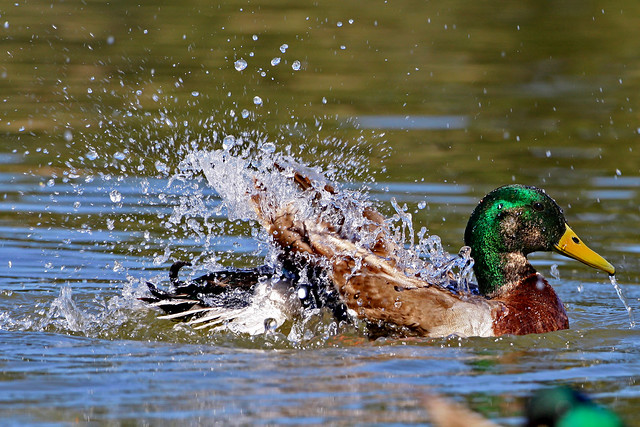 Kids love ducks. They're accessible, and rather big, and you can feed them. (If you're feeding ducks use corn, leafy veggies, or cat food/dog food with large amounts of cornmeal. Bread is bad for them, and they gobble this other stuff up.) I really have to hand it to ducks, putting up with so many kids and doing nothing more extreme when harassed than waddling away in an annoyed fashion. (My son has made many an enemy, and probably made me some parent enemies, by lecturing kids everywhere on proper duck treatment.)
Kids love ducks. They're accessible, and rather big, and you can feed them. (If you're feeding ducks use corn, leafy veggies, or cat food/dog food with large amounts of cornmeal. Bread is bad for them, and they gobble this other stuff up.) I really have to hand it to ducks, putting up with so many kids and doing nothing more extreme when harassed than waddling away in an annoyed fashion. (My son has made many an enemy, and probably made me some parent enemies, by lecturing kids everywhere on proper duck treatment.)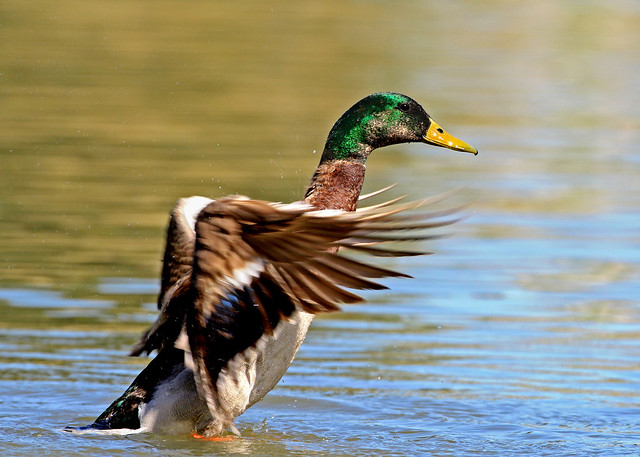 Interestingly, a duck has been allegedly worshiped at least once ... as a demon. According to Pope Gregory IX in the thirteenth century, the demon Asmodi appeared to his followers as a duck. They danced around him, kissed him, and promptly fell into wild satanic orgies. Which probably looked something like the kids at the park.
Interestingly, a duck has been allegedly worshiped at least once ... as a demon. According to Pope Gregory IX in the thirteenth century, the demon Asmodi appeared to his followers as a duck. They danced around him, kissed him, and promptly fell into wild satanic orgies. Which probably looked something like the kids at the park.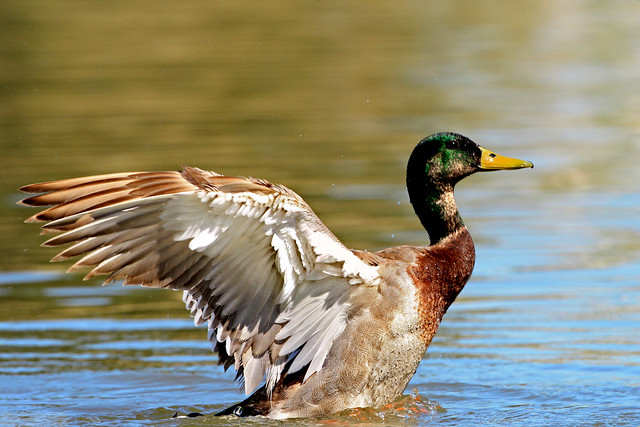
Day 42: Northern shoveler, Anas clypeata
 Yeah, another duck. These guys are awesome, with their improbably giant bills and vivid plumage. I guess I should include something nice about ducks after the demon story, so I can tell you that in many cultures, ducks are seen to represent connections between worlds, as they seem at home in the water, in the air, and on land. This is illustrated beautifully with shovelers, whose bills dabble up vast quantities of bugs and vegetation from the water as the sky's light hits them strikingly from any angle, highlighting the head to look forest green from one angle and deep indigo violet from another. There's even a duck creation myth in which the duck shoveled bits of mud to the top of the water to make land, and I've always imagined it to be a shoveler. The female looks similar in marking and color to a female mallard, but look for the giant bill.
Yeah, another duck. These guys are awesome, with their improbably giant bills and vivid plumage. I guess I should include something nice about ducks after the demon story, so I can tell you that in many cultures, ducks are seen to represent connections between worlds, as they seem at home in the water, in the air, and on land. This is illustrated beautifully with shovelers, whose bills dabble up vast quantities of bugs and vegetation from the water as the sky's light hits them strikingly from any angle, highlighting the head to look forest green from one angle and deep indigo violet from another. There's even a duck creation myth in which the duck shoveled bits of mud to the top of the water to make land, and I've always imagined it to be a shoveler. The female looks similar in marking and color to a female mallard, but look for the giant bill.
That's it from me this week. What are some of your favorite recent sightings?
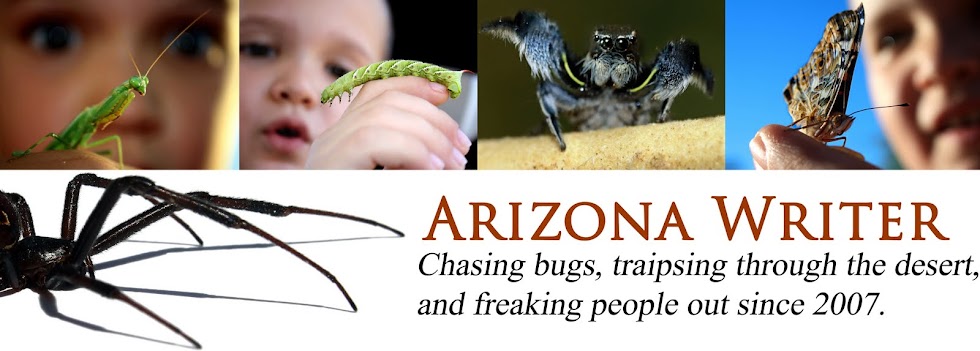
3 comments:
No new species sightings recently, but was glad to see that our local crow with the deformed beak is still going strong 4 years after I first saw him, and building a nest with his mate in a new tree after his old one was cut down last year. We call him Edward Scissorbill; I ran into a fellow feeding dog chow to Ed and his kin the other day, and he says they've always called him plain Bill.
Oh goodness do I love that first shot of the heron! So fun! I know I SHOULD say I like the crane flies best being the bug lover that I am, but herons have a special place in my heart too. Gotta love shore birds!
Christina: How wonderful! I'm glad you guys are looking out for him.
DW: Thanks! It's a favorite shot of mine too.
Post a Comment